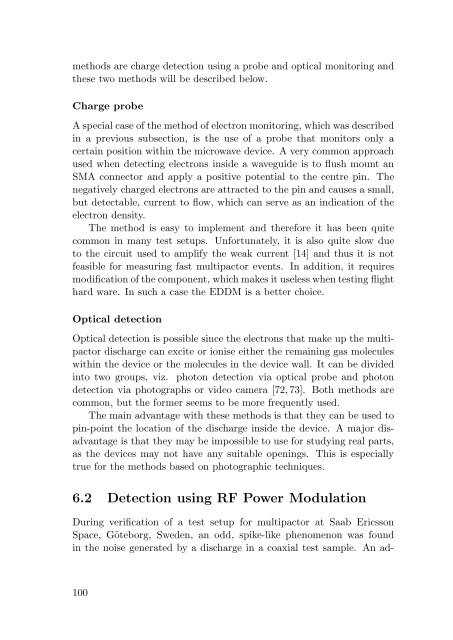Multipactor in Low Pressure Gas and in ... - of Richard Udiljak
Multipactor in Low Pressure Gas and in ... - of Richard Udiljak
Multipactor in Low Pressure Gas and in ... - of Richard Udiljak
Create successful ePaper yourself
Turn your PDF publications into a flip-book with our unique Google optimized e-Paper software.
methods are charge detection us<strong>in</strong>g a probe <strong>and</strong> optical monitor<strong>in</strong>g <strong>and</strong><br />
these two methods will be described below.<br />
Charge probe<br />
A special case <strong>of</strong> the method <strong>of</strong> electron monitor<strong>in</strong>g, which was described<br />
<strong>in</strong> a previous subsection, is the use <strong>of</strong> a probe that monitors only a<br />
certa<strong>in</strong> position with<strong>in</strong> the microwave device. A very common approach<br />
used when detect<strong>in</strong>g electrons <strong>in</strong>side a waveguide is to flush mount an<br />
SMA connector <strong>and</strong> apply a positive potential to the centre p<strong>in</strong>. The<br />
negatively charged electrons are attracted to the p<strong>in</strong> <strong>and</strong> causes a small,<br />
but detectable, current to flow, which can serve as an <strong>in</strong>dication <strong>of</strong> the<br />
electron density.<br />
The method is easy to implement <strong>and</strong> therefore it has been quite<br />
common <strong>in</strong> many test setups. Unfortunately, it is also quite slow due<br />
to the circuit used to amplify the weak current [14] <strong>and</strong> thus it is not<br />
feasible for measur<strong>in</strong>g fast multipactor events. In addition, it requires<br />
modification <strong>of</strong> the component, which makes it useless when test<strong>in</strong>g flight<br />
hard ware. In such a case the EDDM is a better choice.<br />
Optical detection<br />
Optical detection is possible s<strong>in</strong>ce the electrons that make up the multipactor<br />
discharge can excite or ionise either the rema<strong>in</strong><strong>in</strong>g gas molecules<br />
with<strong>in</strong> the device or the molecules <strong>in</strong> the device wall. It can be divided<br />
<strong>in</strong>to two groups, viz. photon detection via optical probe <strong>and</strong> photon<br />
detection via photographs or video camera [72,73]. Both methods are<br />
common, but the former seems to be more frequently used.<br />
The ma<strong>in</strong> advantage with these methods is that they can be used to<br />
p<strong>in</strong>-po<strong>in</strong>t the location <strong>of</strong> the discharge <strong>in</strong>side the device. A major disadvantage<br />
is that they may be impossible to use for study<strong>in</strong>g real parts,<br />
as the devices may not have any suitable open<strong>in</strong>gs. This is especially<br />
true for the methods based on photographic techniques.<br />
6.2 Detection us<strong>in</strong>g RF Power Modulation<br />
Dur<strong>in</strong>g verification <strong>of</strong> a test setup for multipactor at Saab Ericsson<br />
Space, Göteborg, Sweden, an odd, spike-like phenomenon was found<br />
<strong>in</strong> the noise generated by a discharge <strong>in</strong> a coaxial test sample. An ad-<br />
100


